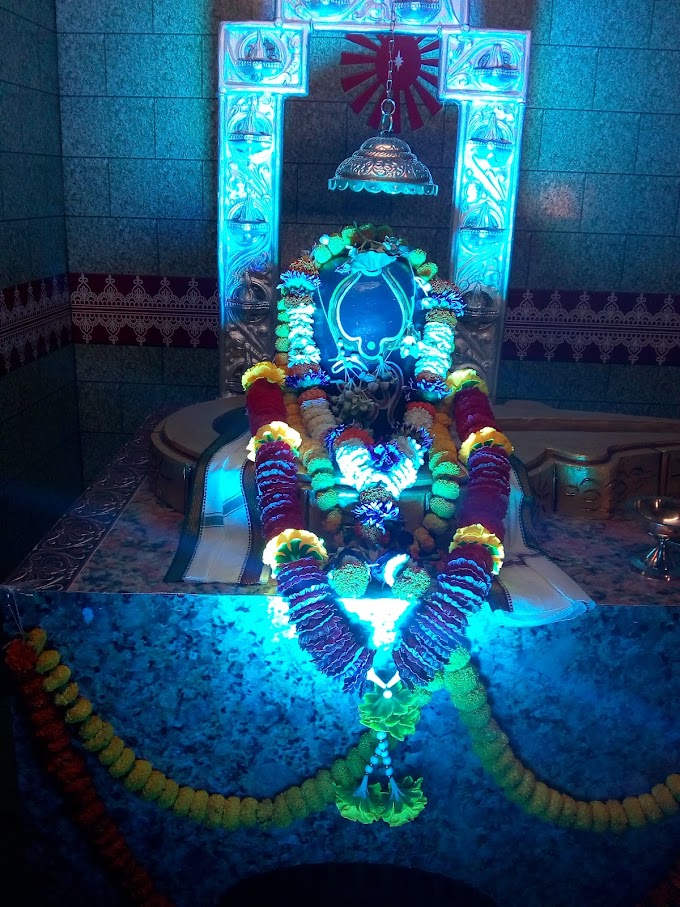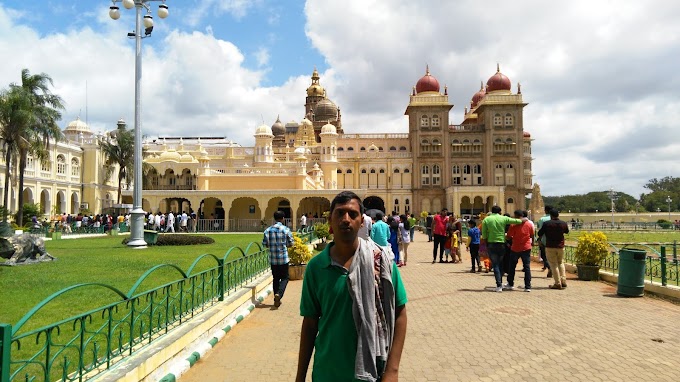LORD LINGARAJ TEMPLE
This
temple is an ancient and famous Shiva temple in Orissa. Many mythology are
attached with this temple. there are around 700 ancient temple found in this
city and such huge numbers of temples never seen in other city for which this
city is call temple city of India.
Lord Lingaraj temple is covered with many temples both inside of the campus and outside of the campus. All temples are ancient temples and some of temples are scratched condition. In the below photo you may find a majestic mountain and landscape. I have capture the video of the temple during the night time which is seen wonderful to see the video click here.
MEANING OF LORD LINGARAJA
The word “LINGARAJA” literally means “the King of Lingam” and
“Linga” is the iconic of Shiva. Shiva was originally worshipped as Kirtivasa
and later as Harihara and is commonly referred to as Tribhuvaneshwara (also
called Bhubaneswar), the master of three worlds, namely, heaven, earth, and
netherworld.
This temple was constructed in the rulling period of King Jajati
Keshari and it is believed that the King deputed Brahmins to worship Lord, who had
migrated from North India. The north India Brahmins were increased knowledge of
Shaivism.
Prior to the deputation of
North India Brahmins, the traditional worship practice was in form of tribal
rites and after the deputation, the practice convert to Sanskrit. It is
understood from the records that kings and temple managers of different times
introduced or discontinued certain services, fairs, offerings, and caste-centered
core services during their regime. As of 2020, the temple practiced 36
different services (nijogas).
WHO AND WHEN CONSTRUCTED
Lord Lingaraja Temple is an ancient temple and the department of
Archeologist also declared this temple as ancient monument. The Somavansh King
Jajati Keshari constructed the temple in the year of 11th century
(1025 to 1040). During that time many temples were constructed and arts and
design of all the temples are on akin. The temple construction period was from 1025
to 1040 (it was taken 15 years to complete) and the total expenses occurred
according to present scenario i.e. Rs. 200 Crore.
The campus of the temple is full with many small temple and all
the temple were constructed during that period. The temple is covered by many
ancient temple and some of them are in scratched situation. Many
Shiva temples were constructed during Somavansh dynastic.
TEMPLE:-
Lord Lingaraja Temple is a Hindu temple dedicated to Shiva (this
is place Lord Shiva worship in form of "Lingam[i]”)
and is one of the oldest and largest temple in Bhubaneswar. The temple is the
most prominent landmark of Bhubaneswar city and one of the major tourist
attractions of the state. The central tower of the temple is 180 ft[1]
(55 m) tall. The temple represents the quintessence of the Kalinga
architecture and culminating the medieval stages of the architectural
tradition at Bhubaneswar. The temple is believed to be built by the kings
from the Somavamsi dynasty, with later additions from the Ganga rulers.
The temple is built in the Deula style that has four components
namely, Vimana (structure containing the sanctum), Jagamohana
(assembly hall), Natamandira (festival hall)
and Bhoga-mandapa (hall of offerings), each increasing in the height
to its predecessor. The Lingaraja temple faces east and is built of sandstone
and laterite. The main entrance is located in the east, while there are small
entrances in the north and south. The temple complex has 50 other shrines and
is enclosed by a large compound wall. Bhubaneswar is called the Ekamra Kshetra
as the deity of lord Lingaraja was
originally under a mango tree (Ekamra) as noted in Ekamra Purana. The
temple is active in worship practices, unlike most other temples in Bhubaneswar
and Shiva is worshiped as Hari-Hara, a combined form of Vishnu and Shiva.
The temple has images of Vishnu, possibly because of the rising prominence
of Jagannath sect emanating from the Ganga rulers who built
the Jagannath Temple in Puri in the 12th century.
It is attributed the raising prominence of Jagannath sect that
became predominant during the construction of the temple. The Gangas remodeled
the temple and introduced certain Vaishnavite elements like images of Vaishnava
Dwarapalas namely Jaya and Prachanda, Jagannatha, Lakshmi Narayan and Garuda
were installed. Tulsi leaves, which are favored by Vishnu, was used along with
Bela leaves for the worship of lord Lingaraja. Thus Lord Lingaraja came to be
known as Harihara, a combination of Shiva and Vishnu. The flag of the temple
was fixed to a Pinaka bow instead of trident usually found in Shiva temples.
The temple priests also changed the mark in their forehead from horizontal to a
"U" sign with a dotted middle line. The Gangas also introduced certain
fairs like Swing festival, Sun worship and mock quarrel between priests after
chariot festival, similar to the practises in Jagannath Temple in Puri. The
influence of the Ganga dynasty has led to cosmopolitan culture.
Lingaraj Temple, built in 11th century, is dedicated to Lord
Shiva and is considered as the largest temple of the city. Built by King Jajati
Keshari of Soma Vansh, the main tower of this temple measures 180 feet in
height. It is built in red stone and is a classic example of Kalinga style of
architecture. The temple is divided into four sections―Garbh Griha (sanctum
sanctorum), Yajna Shala (the hall of yajnas), Bhoga Mandap (the hall of
offering) and the Natya Shala (hall of dance), and the spacious courtyard of
the magnificent shrine comprises 50 small temples that are dedicated to several
Gods of the Hindu pantheon. In the sanctum sanctorum, the linga of Lord Shiva
is regarded as 'Swayambhu' (self-originated) and worshipped as both Lord Shiva
and Lord Vishnu. It is said that when construction of Lingaraj Temple was about
to be completed, Jagannath culture started growing in Odisha. Hence, the
presiding deity here is known as Hari-Hara; Hari denotes Lord Vishnu and Hara
meaning Lord Shiva. The Shiva-linga in the sanctum of the temple rises to a
height of 8 inches above the floor level, and is 8 feet in diameter. Although
thousands of devotees visit lord Lingaraj every day, the temple comes alive on
the occasions of Shivaratri and Rukuna Rath Yatra.
This temple is only accessible to Hindus. Located to the north of the temple is Bindusagar Lake. About 1300 ft long and 700 ft wide, this lake turns into a visual delight when thousands of people set sail tiny boats on the occasion of Boita Bandana that commemorates Odisha’s rich maritime history. On the western banks of the lake, lies the beautiful garden of Ekamravan (literally meaning one-mango-tree forest). Ekamravan finds mention in ancient Hindu mythological texts as an entire forest that comprised a single mango tree. It was a key element in the abode of Lord Shiva and his divine consort, Goddess Parvati. A variety of plants traditionally associated with Hindu gods and goddess and having spiritual and medicinal significance can be found in Ekamravan.
Rukuna Rath Yatra:-
Rukuna Rath Yatra of Lord Lingaraj in Bhubaneswar is one of the
biggest festival in the city of Bhubaneswar. The Chariot Festival of Lord
Lingaraja is on the day of Ashokastami or Basanti Durga Puja. The festival
takes place in the month of March to April (“Chaitra Masa” odia month) the day preceding Ramanavami. On the day of
Ashokastami 3 deities are ceremonially brought to ascend chariot i.e.
‘Chandrasekhar’ the representative of lord Lingaraja, Rukmini & Basudeva.
After that, the chariot is drawn to Rameswara temple and remained there for
four days called Gundicha Gharand on the fifth day the three deities start the
return journey called Bahuda.
The other festival are Shiva Ratri and Shiva Bibaha are also the
biggest festival in this temple. thousand of devotes are together in this place
and the festival continued till mid night.
Lord Lingaraj is not only famous in Orissa but also famous in
India. Many devotes are coming from other part of India and also every day some
foreigner may find in this place also.













